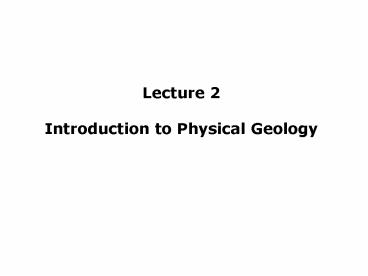Introduction to Physical Geology - PowerPoint PPT Presentation
1 / 21
Title:
Introduction to Physical Geology
Description:
What is a Planet? Physical Geology (1) A 'planet'1 is a celestial body that (a) is in orbit around the Sun, (b) has ... body forces so that it assumes a ... – PowerPoint PPT presentation
Number of Views:535
Avg rating:3.0/5.0
Title: Introduction to Physical Geology
1
Lecture 2 Introduction to Physical Geology
2
Lecture Outline
Physical Geology
I Geological Paradigms II Origins A) The Solar
System B) The Earth III Fundamental Concepts of
Physical Geology A) Geologic Time B) The
Earth's Structure i. Earth's
Layers ii. Plate Tectonics - From
Continental Drift to Plate Tectonics - Lithosp
heric Plates - Plate Boundaries C) The Rock
Cycle IV Planetary Geology V Conclusions
3
Geological Paradigms
Physical Geology
paradigm, n a collection of beliefs shared by
scientists a set of agreements about how
problems are to be understood
James Ussher (1581-1656) catastrophism
James Hutton (1726-1797) uniformitarianism rock
cycle
Charles Lyell (1797-1875) geologic time
Alfred Wegener (1880-1930) continental drift
4
Origin of the Solar SystemThe Nebular Hypothesis
Physical Geology
Palomar Observatory
5
Origin of the Solar SystemThe Nebular Hypothesis
Physical Geology
6
Origin of the Solar SystemThe Nebular Hypothesis
Physical Geology
gravity
physical collision
clumps of dust grains (cm)
Planetesimals (km)
planetesimals (10-100 km)
protoplanet (100-1000km)
7
The Solar SystemWhat is a Planet?
Physical Geology
(1) A planet1 is a celestial body that (a) is
in orbit around the Sun, (b) has sufficient mass
for its self-gravity to overcome rigid body
forces so that it assumes a hydrostatic
equilibrium (nearly round) shape, and (c) has
cleared the neighbourhood around its orbit. (2)
A dwarf planet is a celestial body that (a) is
in orbit around the Sun, (b) has sufficient mass
for its self-gravity to overcome rigid body
forces so that it assumes a hydrostatic
equilibrium (nearly round) shape2 , (c) has not
cleared the neighbourhood around its orbit, and
(d) is not a satellite. (3) All other objects3
except satellites orbiting the Sun shall be
referred to collectively as Small Solar-System
Bodies.
8
Origin of the EarthGeological Differentiation
Physical Geology
- Earth melted by
- gravitational energy left from formation of
planet - meteor bombardment
- radioactive decay
- Gravity concentrated denser materials (Ni Fe)
in center - Less dense materials (silicates) forced to outer
layers - Crust became stable after 1 billion years
- Compositional Zones
- Crust
- Continental
- Oceanic
- Mantle
- Core
- Outer (Liquid)
- Inner (Solid)
9
Fundamental ConceptsEarth's Layers
Physical Geology
- Compositional Zones
- Core
- Solid inner core
- Liquid outer core
- Radius of 3500 km
- 16.2 of Earth's vol.
- 31.5 of Earth's mass
- Generates Earth's magnetic field
- Mantle
- Thickness 2900 km
- 82.3 of Earth's vol.
- 67.8 of Earth's mass
- Crust
- Oceanic 4-20km thick
- Continental 30-70km thick
- Mechanical Zones
- Core
- Mesosphere
- Lower mantle
- Rigid
- Very Hot
- Capable of gradual flow
- Asthenosphere
- "weak" layer
- Convecting mantle
- Soft and readily flows
- Lithosphere
- Crust and Upper Mantle
- Rigid
- Brittle
10
Fundamental ConceptsGeologic Time
Physical Geology
- Phanerozoic Eon -"Eon of Evident Life"
- Paleozoic Era -"Era of Old Life"
- Mesozoic Era -"Era of Middle Life"
- Cenozoic Era -"Era of Modern Life"
Divisions Eon Era Period Epoch Age
11
Fundamental ConceptsPlate Tectonics - The
Evidence
Physical Geology
12
Fundamental ConceptsPlate Tectonics - The Ocean
Floor
Physical Geology
Mid-Ocean Ridge System
13
Fundamental ConceptsPlate Tectonics - The Ocean
Floor
Physical Geology
Mid-Ocean Ridge System
- underwater mountain range
- 80,000 km long
- 1500-2500 km wide
- up to 3000 m above sea floor
- rift valley, 1-2 km deep, runs along axis
- 4000 km wide fracture systems
14
Fundamental ConceptsPlate Tectonics - The Ocean
Floor
Physical Geology
magnetic striping
crustal age
15
Fundamental ConceptsPlate Tectonics - The Ocean
Floor
Physical Geology
16
Fundamental ConceptsPlate Tectonics - The Engine
Physical Geology
17
Fundamental ConceptsPlate Tectonics -
Lithospheric Plates
Physical Geology
18
Fundamental ConceptsPlate Tectonics Plate
Boundaries
Physical Geology
19
Fundamental ConceptsThe Rock Cycle
Physical Geology
- Atmospheric Processes
- Weathering
- Physical Weathering
- Chemical Weathering
- Biological Weathering
- Sediment Transport
- Lithospheric Processes
- Burial
- Compaction and Cementation
- Heat and Pressure
- Stress
- Plate Tectonics
- Exposure
20
Planetary Geology
Physical Geology
Venus
Jupiter
Europa
Magellan
Galileo
Io
Mars
Galileo
Viking 1
Voyager 1
21
Planetary GeologyMars
Physical Geology
Physical Geology































